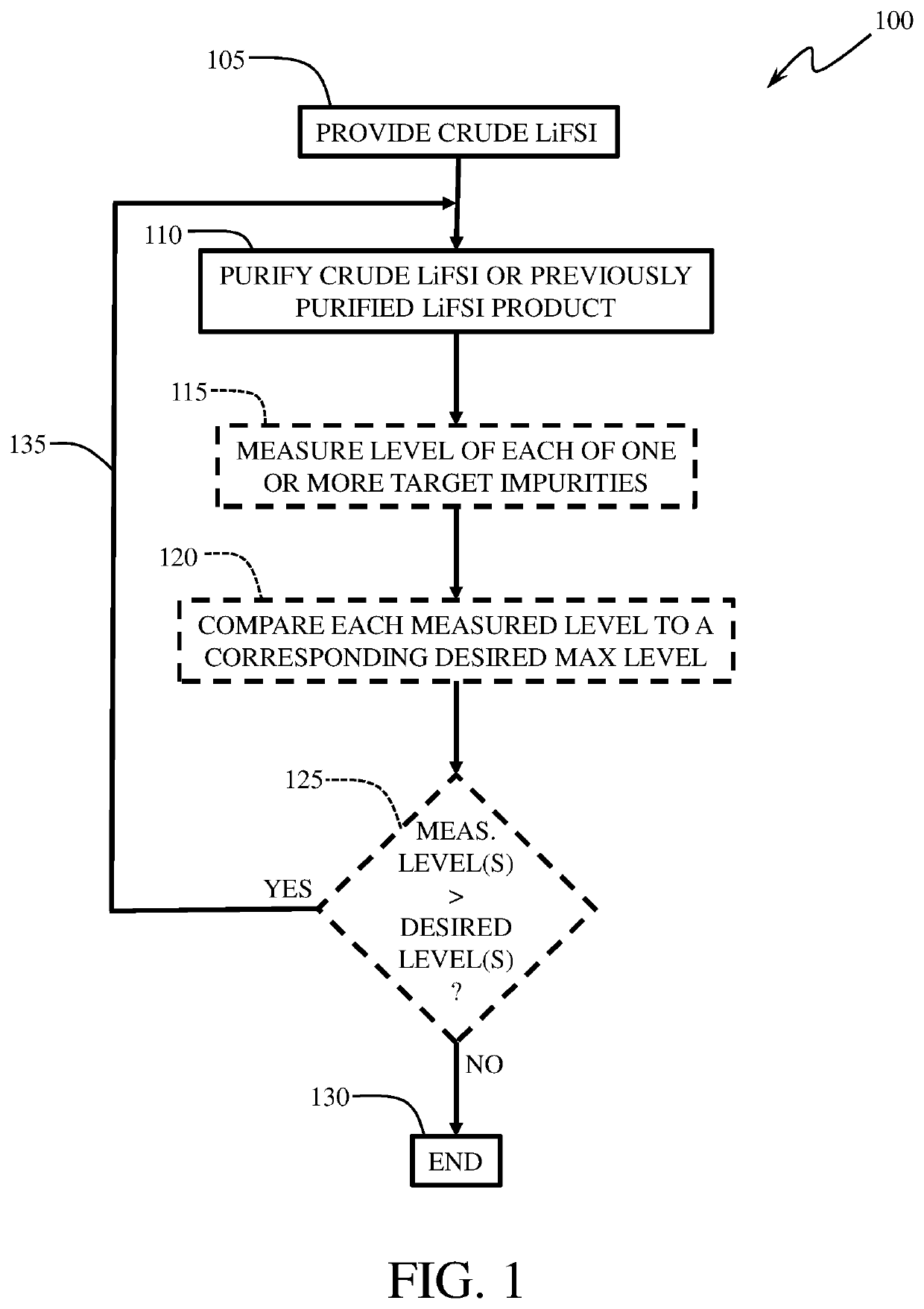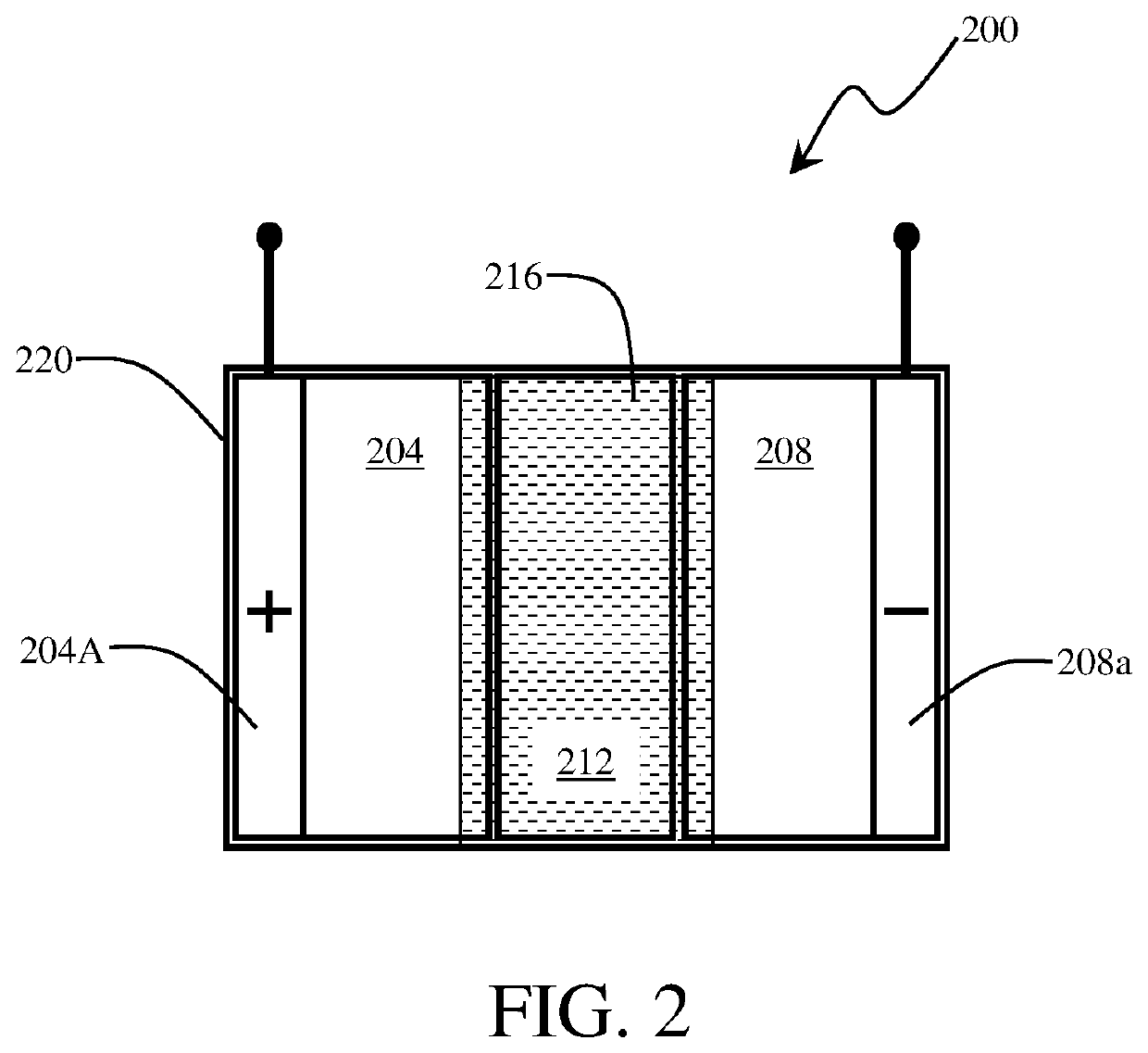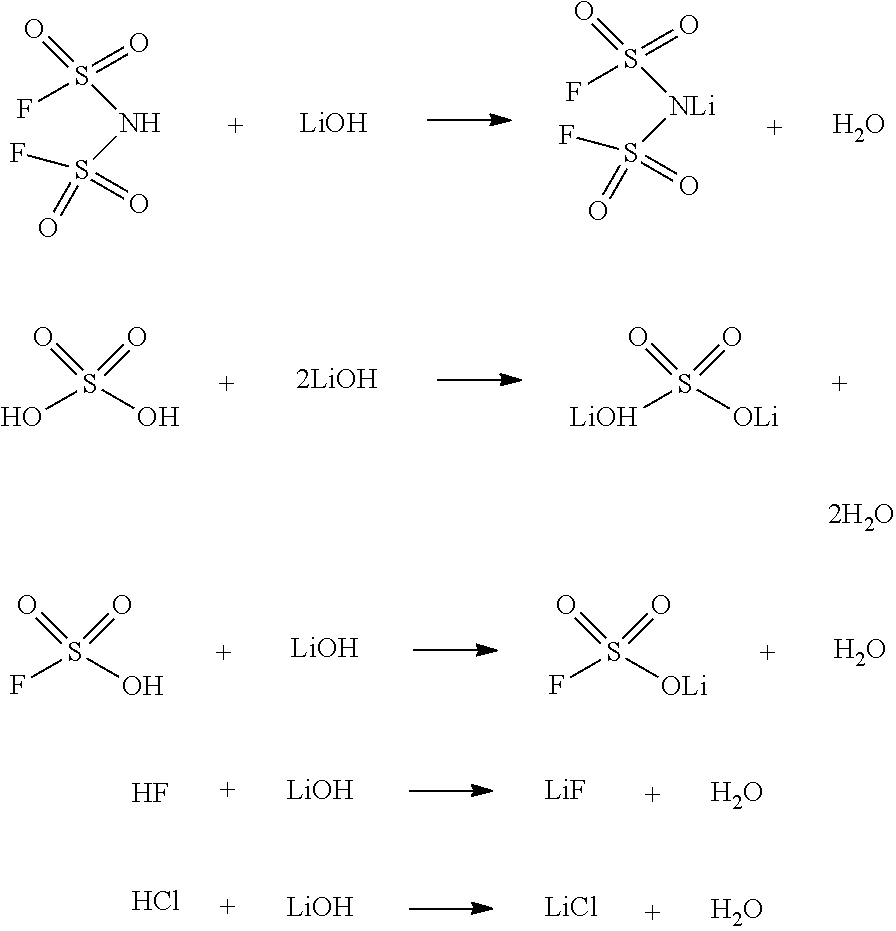Purified Lithium Bis(fluorosulfonyl)imide (LiFSI) Products, Methods of Purifying Crude LiFSI, and Uses of Purified LiFSI Products
- Summary
- Abstract
- Description
- Claims
- Application Information
AI Technical Summary
Benefits of technology
Problems solved by technology
Method used
Image
Examples
example 1
[0047]Purification of LiFSI using dimethyl carbonate (DMC) and dichloromethane: In a 500 mL dry flask, crude LiFSI (250 g) containing various level of impurities, here, FSO3−=400 ppm, Cl−=50 ppm, F−=200 ppm, SO42−=200 ppm, and water=200 ppm, was taken under a nitrogen atmosphere and cooled to 10° C. with a water bath. Anhydrous DMC (250 g (50 wt. %)) was added to the flask portion-wise with stirring, followed by an addition of 20 g (4 wt. %) of anhydrous dichloromethane. The mixture was stirred at room temperature for 1 hour. Insoluble impurities were removed from the mixture by filtration. The filtrate was concentrated at reduced pressure to obtain a solid, which was then treated with anhydrous dichloromethane (200 g) under argon. The mixture was stirred at room temperature for 1 hour, and the desired insoluble LiFSI product was isolated by filtration and finally dried at 35° C. in vacuo (3−=100 ppm; Cl−=10 ppm; F−=50 ppm; SO42−=60 ppm; and water=50 ppm.
example 2
[0048]Purification of LiFSI using ethyl methyl carbonate (EMC) and dichloromethane: In a 500 mL dry flask, crude LiFSI (250 g) with various level of impurities, here, FSO3−=200 ppm, Cl−=10 ppm, F−=100 ppm, SO42−=100 ppm, and water=100 ppm, was taken under a nitrogen atmosphere and cooled to 10° C. with a water bath. Anhydrous EMC (200 g; (˜44 wt. %)) was added to the flask portion-wise with stirring, followed by addition of 25 g (˜5.6 wt. %) of anhydrous dichloromethane. The mixture was stirred at room temperature for 1 hour. Insoluble impurities were removed by filtration. The filtrate was concentrated at reduced pressure to obtain a solid, which was then treated with anhydrous dichloromethane (250 g) under argon. The mixture was stirred at room temperature for 1 hour, and the desired insoluble LiFSI product was isolated by filtration and finally dried at 35° C. in vacuo (3−=40 ppm; Cl−=1 ppm; F−=10 ppm; SO42−=20 ppm; and water=30 ppm.
example 3
[0049]Purification of LiFSI using Diethyl carbonate (DEC) and dichloromethane: In a 500 mL dry flask, crude LiFSI (250 g) containing various level of impurities, here, FSO3−=400 ppm, Cl−=50 ppm, F−=200 ppm, SO42−=200 ppm, and water=200 ppm, was taken under a nitrogen atmosphere and cooled to 10° C. with a water bath. Anhydrous DEC (250 g (50 wt. %)) was added to the flask portion-wise with stirring, followed by addition of 20 g (4 wt. %) of anhydrous dichloromethane. The mixture was stirred at room temperature for 1 hour. Insoluble impurities were removed from the mixture by filtration. The filtrate was concentrated at reduced pressure to obtain a solid, which was then treated with anhydrous dichloromethane (200 g) under argon. The mixture was stirred at room temperature for 1 hour, and the desired insoluble LiFSI product was isolated by filtration and finally dried at 35° C. in vacuo (3−=80 ppm; Cl−=5 ppm; F−=30 ppm; SO42−=50 ppm; and water=45 ppm.
PUM
| Property | Measurement | Unit |
|---|---|---|
| Temperature | aaaaa | aaaaa |
| Temperature | aaaaa | aaaaa |
| Temperature | aaaaa | aaaaa |
Abstract
Description
Claims
Application Information
 Login to View More
Login to View More - R&D
- Intellectual Property
- Life Sciences
- Materials
- Tech Scout
- Unparalleled Data Quality
- Higher Quality Content
- 60% Fewer Hallucinations
Browse by: Latest US Patents, China's latest patents, Technical Efficacy Thesaurus, Application Domain, Technology Topic, Popular Technical Reports.
© 2025 PatSnap. All rights reserved.Legal|Privacy policy|Modern Slavery Act Transparency Statement|Sitemap|About US| Contact US: help@patsnap.com



